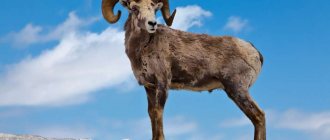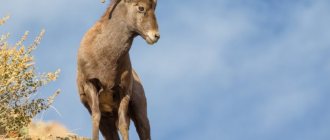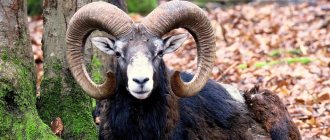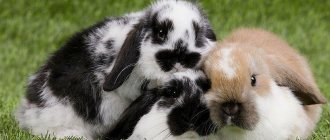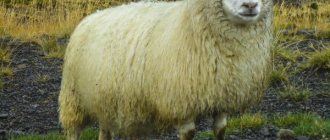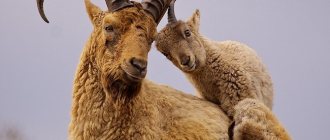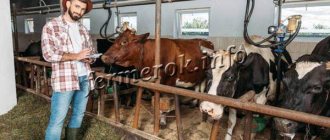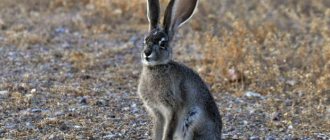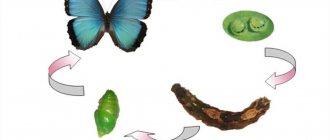The Altai sheep or Kochkor is the largest of the ten subspecies of mountain sheep. In Russia, in addition to Altai, it is also found in Tyva. In addition to the territory of Russia, the subspecies has been registered in Mongolia. In general, this habitat can be considered as a single whole within which animals make their seasonal migrations. The population is low and the animal is endangered. Hybrids of Altai ram with domestic sheep, which are bred in Mongolia, are economically valuable.
Description of the Altai ram
The Altai ram is a large, slender, proportionally built animal. Males are about 120 cm in height, females up to 115 cm, weight is about 200 and 100 kg, respectively. Both sexes have horns. In old males they are very impressive, up to 151 cm in length, 55 cm in diameter at the base, weight up to 22 kg. Females have smaller horns. Winter wool is colored from brown-brown to light gray-reddish. The belly and area around the tail are always lighter in color, ranging from whitish-yellow to almost white. Old males are darker than young and females. The summer color is bright, made in brownish-reddish tones.
Mountain sheep nutrition
Argali are herbivores whose diet consists of grasses, greens and sedges. Females and young lambs live in the highlands, where the quality of food is much worse compared to the flatlands.
Argali are located in areas where there are no trees, and at the same time there is a lot of vegetation suitable for them. In such a feeding area, the ram is protected from carnivores. Adult rams, which are larger in size compared to females and young argali, choose for feeding areas a little lower, where better vegetation can be found, while young animals and females are located much higher, where plant resources are not so rich.
Altai argali have been able to adapt to survive in the arid, windy and extreme conditions of the highlands. The daily norm for an adult argali is from 16 to 19 kg of vegetation. The food these animals prefer may vary depending on the altitude and area of the area.
In higher mountainous areas, the main diet consists of grass and sedge. If rams live at the middle level, most often their menu includes green shrubs and mesophytic grasses. The lower ridges and desert spurs are rich in grasses and sedges, but of a different variety compared to the highlands.
In some habitats of argali, shoots, foliage, flowers and fruits are an important part of the diet, throughout the year, but in other areas where the animals live, such food is rare. Argali needs water. This is not a difficulty for individuals that live in the highlands, where snow periodically melts and small streams are found.
If a ram lives in a dry area, it is able to travel a considerable distance to find water. Argali also love to feast on saline soils.
Distribution of the Altai sheep
At this time, three isolated micropopulations of the Altai sheep are known: near the borders of Mongolia with China, on the Sailyugem ridge and in the mountains near the upper reaches of the Chulyshman River.
The main habitats are mountain steppes located near the foot of the ridges, as well as open areas on slopes at an altitude of 2000-3000 m and higher above sea level. There is no forest vegetation here, but there are thickets of bushes. Herbaceous vegetation here includes small-herb cereals, cereal-legumes, and grass-cobresia associations. Altai sheep use stone screes, steep slopes, and snowfields as shelters. In the warm season, animals go to salt licks every 2-3 days and rarely go to water.
Place of residence
Now Altai mountain goats can be found in three regions:
- near the Chulyshman River;
- on the Sailyugem mountain range;
- in the border zone between China and Mongolia.
The area where these animals live is classified as a nature reserve and is a protected area.
The favorite place of Altai argali is mountainous areas. Moreover, mountain sheep do not require abundant vegetation - they can be content with small shrubs belonging to the round-leaved subspecies.
In the summer months, argali are able to eat food up to 2-3 times a day, but replenishment of water reserves in the body is carried out once every three days.
Male and female Altai ram: main differences
In Altai sheep, sexual dimorphism is quite pronounced. Firstly, males are always larger than females - 5-10 cm in height and up to 100 kg in weight. Secondly, the horns of females are always much more modest, smaller and thinner than those of males. Finally, the coat color of males is brighter and darker, while females are painted in lighter colors.
Number
At the beginning of the 20th century, there were approximately 600 heads of Altai argali. Over time, their population sharply decreased to 245 individuals. Thanks to the implementation of actions to protect and relocate mature animals to the territory of the reserves, their number was slightly increased - up to 320 animals, this includes cubs, as well as mature animals.
In German and American zoos, attempts were made to breed argali in an artificial environment, but all of them were unsuccessful. Most often, mountain sheep died after a few weeks. The argali, which was bred by scientists from the Russian Biological Institute, lived the longest (for 6 years). As a result, it became obvious that such herbivores can survive exclusively in their natural environment, or in one as similar as possible.
Attempts to save the subspecies and increase the number are being carried out at the Novosibirsk Zoo. This is the only establishment in the world where you can see Altai argali up close. In addition, it is even possible to obtain offspring from the mountain sheep kept in this institution.
Researchers working at the zoo have drawn up a plan on how to raise and release young argali into the wild. As part of these activities, four males were released into the wild in 2022, who were raised in a separate pen.
The actions were successful, and the rams disappeared into the forest. According to experts, there should be a meeting with a large group of wild argali living at the release site, and the released animals should join them.
Behavior of the Altai ram
— Advertising —
Altai sheep are characterized by regular seasonal migrations. They can be very clearly traced using the example of the Sailyugem micropopulation. In spring, animals will move from the southern slopes to the northern ones, in more comfortable conditions. In autumn they migrate in the opposite direction. In addition to the natural and climatic factor, the timing of migration of Altai sheep is also determined by the migrations of livestock breeders with their livestock. For example, in Altai, cattle are driven to the northern slopes in October, and back in the spring, which also affects the movements of wild sheep.
In general, Altai sheep are perfectly adapted to the harsh climatic conditions of the southern high mountain regions. They are able to withstand the most severe winter frosts, strong winds, even without reliable shelter. But in captivity, animals usually feel poorly, despite the favorable climatic conditions that are created for them.
Altai sheep live in small groups of two types: bachelor males gather separately and females with young animals gather separately.
Enemies of argali in the natural environment
Security for argali lies in their numbers. Mature rams are larger in size and capable of developing greater speed compared to females, so they do not particularly need protection from carnivores. As a result, they can live closer to the plains, while females and young males have to give preference to high mountain areas. They rarely use horns for protection.
The main advantage of argali during attacks by predatory animals is their speed. A female mountain sheep wandering alone, when frightened, can freeze in a motionless position and remain in this position until the threat disappears. This is the difference in the behavior of females living in a herd: upon noticing a threat, they run and jump.
Males, due to their large size, can hardly jump, so they do not use jumping to hide from the enemy, but this technique is often used to protect small females and young individuals. Thanks to their strong, long limbs, argali are capable of moving on any type of surface. Most often they live in places inaccessible to predators. Argali usually choose high hills or steep embankments to live, where there is a good viewing platform.
Gray wolf: enemy of the Altai sheep
Mountain sheep in their natural environment have to defend themselves from the following predators:
- gray wolves;
- snow leopards;
- leopards;
- snow leopards;
- cheetahs.
Small argali are hunted by coyotes and large birds of prey - eagles and golden eagles. In addition, mountain sheep often become prey for people who actively destroy representatives of this group of animals in order to obtain expensive horns, meat and skin.
As for predators, wolves are in first place in terms of the level of destruction of mountain sheep, often taking advantage of harsh winter conditions (for example, in the form of deep snow) to catch herbivores.
Important! To avoid the threat of predators, mountain sheep move in a herd and stay in a group.
Reproduction of the Altai sheep
The mating season for Altai sheep lasts from January to early March.
At this time, males behave very aggressively and actively fight with each other for females, clashing horns or hitting their opponents in the sides and chest. Sexual maturity in females occurs at the age of 18 months, in males - at approximately 30 months. The duration of pregnancy is about 5 months. The birth of lambs occurs away from the group, to which the female returns a few weeks later, when the baby is strong enough. The life expectancy of the Altai sheep is from 12 to 18 years.
Distinctive features of argali, their way of life
Mountain sheep are herding animals, most often living in groups of 2 to 100 individuals. Males and females live separately, with the exception of the breeding season. The herd is usually dominated by adult females, their number makes up more than half of the population, the rest of the population consists of adult rams of about 20%, as well as young animals of 20%.
Sometimes you can find argali wandering alone, although small numbers of herds are more common. Females and babies live in large groups, most often up to 92 animals, and sometimes you can find herds of about 200 individuals.
Important! Mountain sheep are calm animals; they do not show aggression towards other species. Rams living in a herd continuously follow one another, they often seek communication with their relatives.
The herd may sometimes migrate, especially if it contains males. Most often, migration begins after a seasonal reduction in plant resources; the movement of argali can also be provoked by large numbers of blood-sucking insects, severe drought and fires, poaching and a large number of domestic farm animals.
Altai sheep fighting for a female
Interesting facts about the Altai sheep
- In recent years, scientists have noted a constant decline in the Altai sheep population (up to 200-300 individuals) and its habitat area. Humans have a negative impact on this process. Animals are directly displaced from their natural habitats by herds of domestic animals. Goats and yaks develop the same pastures located in inaccessible areas of the mountains as wild sheep and simply do not leave them food. The higher the number of livestock, the greater the degradation of pastures and the deterioration of the food supply. The second place in terms of negative impact on the Altai sheep population is occupied by poaching. Animals are shot everywhere, even in the Altai Nature Reserve. Another limiting factor was large-scale geological exploration work on the borders of Mongolia with China, when tractors, all-terrain vehicles, and helicopters were actively used. Snowy, harsh winters also have a bad effect on the life of wild sheep, which leads to increased natural mortality. As a result, the Altai mountain sheep population is steadily declining, and individual habitats of the subspecies are simply disappearing.
- They tried to breed Altai mountain sheep in captivity, in zoos, but all attempts were unsuccessful and ended in the death of the animals. The reasons for this phenomenon remain unclear; perhaps the rams need to be kept close to their habitats, or special conditions similar to natural ones should be created. In general, Altai sheep require attention and active protection of people, a complete ban on fishing, the creation of nature reserves and wildlife sanctuaries, otherwise this subspecies will very quickly disappear from the face of our planet.
Breeding
They tried to breed the described species in zoos in Germany and America, but the animals always died after living for several months, or even days. The longest a representative of the Argali genus lived in captivity was 6 years at the Biological Institute of Siberia, Russia.
Obviously, mountain sheep should be kept close to their natural habitat or similar conditions should be created and good care should be provided. Rocks stick together, forming large herds. Females always walk alone. Males always try to move in such a way as to be able to protect their females and cubs in any situation.
Usually the mating season begins in November, the female carries the cubs for 5 months, and already in early May gives birth to only one lamb. Argali lambs are born completely independent and immediately stand on their feet.
Altai mountain sheep are a breed that is on the verge of extinction. It is unique due to its size: its representatives have a large body mass and voluminous horns. Individuals live only on high rocks.
Life cycle features
Sheep reach sexual maturity at 2–3 years. Males and females of all species live in separate herds and create mixed groups only for the mating period, which begins with the arrival of cold weather.
Such groups break up by spring. Males organize fights for the right to own a female. The female's pregnancy lasts from 5 to 6 months. Before giving birth, she retires from the herd to a secluded place. Usually one or two lambs are born, weighing from three to five kg. In natural conditions, sheep live no longer than 15 years.
Population status and species protection
It is very difficult to control the numbers of animals, because their natural habitat is inaccessible terrain. The population decline is due not only to human activity and predators, but also to climate change. Due to the extremely small number of these animals, they were included in the Red Book back in Soviet times, where they remain to this day.
Important! Argali breed poorly in captivity - most attempts to breed them end in failure.
To preserve their population, it is necessary to bring environmental conditions
as close as possible To preserve the species, attempts are being made to breed it in captivity. In addition, a number of legislative acts have been adopted prohibiting argali hunting. Territories where the appearance of these animals is noted are immediately included in the list of protected areas.
But these attempts have not yet yielded any results, because the illegal hunting of argali still continues - at least 2-3 cases of poaching are recorded per year.
Diet
The considered species of fauna belongs to herbivorous mammals. The basis of their diet is various herbaceous vegetation. Animals have a special love for cereals, but if they are not available, they can be content with sedge, solyanka and other herbs that grow in mountainous areas.
One of the features of these animals is their ability to go without water for a long time. The moisture that comes with the pasture is enough for them.
Did you know? In case of urgent need, argali can even drink salt water.
Natural enemies
The main dangers for argali are:
- golden eagles;
- eagles;
- cougars;
- Snow leopards;
- wolves;
- coyotes;
- cheetahs;
- leopards;
- Human.
Birds of prey pose a danger mainly to newborn babies. Large animals attack both young and mature individuals. It is quite difficult to cope with an adult argali, so most predators try to knock them down in order to throw them into the abyss, and only then eat the wounded or already dead animal.
Read about methods for determining the age of rams and sheep by their teeth.
